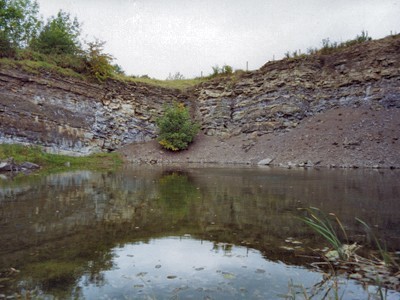Earth Science Conservation Review
| Drummond Quarry, Aughnacloy | Tyrone |
| Site Type: | Quarry (disused) |
| Site Status: | ASSI |
| Council area: | Dungannon District Council |
| Grid Reference: | H690519 |
| Google maps: | 54.41146,-6.93727 |
| Rocks | |
|---|---|
| Rock Age: | Carboniferous (Arundian, Visean) |
| Rock Name: | Bundoran Shale Formation, Tyrone Group |
| Rock Type: | Mudstone |
| Interest | |
| Fossil Groups: | Brachiopod, Coral |
| Other interest: | Marine sediments |
Summary of site:
This abandoned and flooded quarry is the only one in the whole of Northern Ireland excavated entirely into the Bundoran Shale Formation. Despite the flooding, all the faces in the quarry are accessible and, calculating the combined thickness from these outcrops, around 8m of rock can be examined. With the exception of a few weakly developed limestones, the entire thickness of rock consists of thickly and thinly bedded, lime-rich, silty mudstones (almost very impure limestones) and softer, flaky mudstones with far less lime. This entire sequence is inclined 20º to the north.
Fossils are common in the quarry and in the nearby road cutting. There is one important solitary coral species and a few colonial forms, as well as a rich shelly fauna of brachiopods. The corals give a definite Arundian age (around 345 million years), allowing direct comparison with a classic area in southern Cumbria where the fauna was first described.
At the time of deposition the area was on the eastern fringe of a tropical marine basin filling with lime rich muds, well out to sea. The prolific shelly fauna shows that the water was not too deep or turbid and there was a rich food supply. It was off the southern margin of the super continent of Laurentia (now parts of North America, Greenland, Ireland and Britain), at just about the time it was passing from the southern into the northern hemisphere.
Any future development of this quarry will seriously threaten its geological importance.
Fossils are common in the quarry and in the nearby road cutting. There is one important solitary coral species and a few colonial forms, as well as a rich shelly fauna of brachiopods. The corals give a definite Arundian age (around 345 million years), allowing direct comparison with a classic area in southern Cumbria where the fauna was first described.
At the time of deposition the area was on the eastern fringe of a tropical marine basin filling with lime rich muds, well out to sea. The prolific shelly fauna shows that the water was not too deep or turbid and there was a rich food supply. It was off the southern margin of the super continent of Laurentia (now parts of North America, Greenland, Ireland and Britain), at just about the time it was passing from the southern into the northern hemisphere.
Any future development of this quarry will seriously threaten its geological importance.
| Enlander, I., Dempster, M. & Doughty, P., 2025. Drummond Quarry, Aughnacloy, County Tyrone, site summary. [In] Earth Science Conservation Review. https://www.habitas.org.uk/escr/summary.php?item=252. Accessed on 2025-04-03 |
| Previous Site | Next Site |

